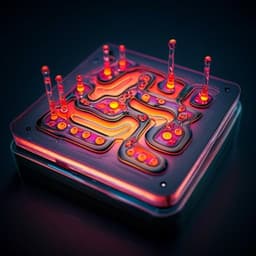
Engineering and Technology
Silicon-photonics-enabled chip-based 3D printer
S. Corsetti, M. Notaros, et al.
This innovative research presents a groundbreaking chip-based 3D printer that leverages silicon photonics and photochemistry. The system employs a compact photonic chip to create reconfigurable holograms, revolutionizing the way 3D objects are printed with precision at sub-millimeter scales. The team from MIT and UT Austin showcases the potential of visible-light curing technologies in this exciting new approach.
~3 min • Beginner • English
Introduction
3D printing has transformed modern manufacturing across markets from consumer products to infrastructure and medicine. As applications have expanded, methods now span high-resolution nanoscale printing to large structures. Common commercial approaches include extrusion, powder-bed fusion, jetting, and light-induced polymerization. At the consumer level, fused deposition modeling (FDM) is prevalent but limited in resolution. Photocuring-based methods such as stereolithography (SLA), digital light processing (DLP), and masked stereolithography (MSLA/LCD) achieve higher resolution but require bulky mechanical systems (laser routing, anti-aliasing, specialized build platforms, precise elevator mechanisms). These mechanical dependencies and layer-by-layer operation constrain portability, form factor, resolution, print speed, and material complexity. Volumetric modalities have been explored to increase build speed and reduce mechanical reliance, yet often still depend on rotating stages or multi-angle illumination frameworks. There is a need for a compact, portable, low-cost 3D-printing technology without moving parts. Silicon photonics, leveraging CMOS fabrication for compact, low-cost optical microsystems, offers a path forward. Integrated optical phased arrays (OPAs) can emit and dynamically control free-space light non-mechanically and at low cost, but prior demonstrations have focused on infrared wavelengths (e.g., LiDAR), incompatible with traditional UV-activated 3D-printing photochemistry. Silicon photonics has not previously been proposed or demonstrated for 3D printing. In this work, the authors propose the first chip-based 3D printer: a single millimeter-scale photonic chip generates reconfigurable visible-light holograms into a stationary resin well for non-mechanical 3D printing. They outline key requirements, then demonstrate a stereolithography-inspired proof of concept using a visible-light OPA and visible-light-curable resin to print voxels, characterize curing rate via voxel size versus exposure time, print 1D lines, and finally arbitrary 2D patterns, establishing the feasibility of chip-based 3D printing.
Literature Review
The paper surveys established 3D-printing modalities: extrusion (e.g., FDM) favored for rapid prototyping and bioprinting but with lower resolution; and photocuring approaches (SLA, DLP, MSLA) which offer higher resolution down to ~10 µm but require complex, bulky mechanics, including laser routing, anti-aliasing, and precise elevator stages. Volumetric 3D-printing strategies promise faster builds and reduced anisotropy but still typically employ rotating stages or multi-angle illumination, maintaining mechanical complexity. In parallel, silicon photonics—particularly integrated optical phased arrays—has enabled compact, electronically reconfigurable beam steering for applications like LiDAR, but these systems have largely operated in the infrared and have not been applied to 3D printing. Thus, there is a gap for a visible-wavelength, photonics-enabled, non-mechanical 3D-printing platform.
Methodology
Proposed concept: A single, flat, millimeter-scale silicon-photonics chip sits at the bottom of a stationary well of visible-light-curable liquid resin. The chip projects reconfigurable visible-light holograms into the resin to induce selective polymerization, enabling volumetric 3D printing without moving parts. Hologram generation: A 2D grid of on-chip visible-light OPAs serves as the aperture pixels. Ideal continuous phase and amplitude distributions for the target hologram are discretized into local one-dimensional phase gradients with arbitrary amplitudes and absolute phases per pixel, and iteratively optimized using the Gerchberg–Saxton algorithm. Encodings (amplitude, absolute phase, phase gradient) are applied via integrated modulators. Photonic platform: The system uses silicon nitride (SiN) waveguides (low visible absorption, CMOS compatible). Because SiN has a low thermo-optic coefficient and negligible electro-optic effect at visible wavelengths, liquid-crystal (LC) material with strong visible birefringence is integrated for dynamic modulation. LC-based phase shifters apply linear phase shifts for beam steering. Electronics: Heterogeneous integration with a co-designed CMOS electronics chip is envisioned for compact driver control. Proof-of-concept SLA-inspired implementation: A visible-light OPA emits and non-mechanically steers a beam into a well of visible-light-curable resin to print voxels, lines, and 2D patterns. OPA architecture (key details): • Input coupling: 637 nm light from an off-chip laser is edge-coupled through an on-chip inverse-taper coupler into a single-mode 160-nm-thick SiN waveguide. • Vertical transition: A ~100 µm adiabatic escalator couples light to a second 160-nm-thick SiN bus waveguide located ~10 nm below an LC-filled trench. • Power distribution: Cascaded evanescent taps, placed with 20 µm pitch and increasing coupling lengths, uniformly distribute light from the bus to 16 vertically stacked and horizontally offset tap waveguides. • Antennas: Tap waveguides route to 16 grating-based uniform-perturbation antennas, each ~400 µm long with 2 µm pitch, emitting out of the chip surface with an exponential emission profile. • Phase control: LC-based phase shifters provide cascaded, linear phase control across the array via electric-field-induced modulation of LC orientation, changing the effective index and imparting a controllable phase shift to each antenna path. Fabrication and packaging: The LC-based cascaded OPA was fabricated in a 300-mm CMOS-compatible silicon-photonics process (SUNY Poly Albany NanoTech Complex). Post-fabrication, chip-scale LC packaging with electrodes and a top glass with alignment layer was performed at MIT. Visible-light-curable resin: A custom three-component photosystem enables efficient curing at visible wavelengths. The photoredox compound (aza-Br) is synthesized and halogenated to increase intersystem crossing to long-lived triplet states, enhancing reaction efficiency. Aza-Br exhibits peak extinction around 660 nm, compatible with 637 nm operation. Two coinitiators (Borate V and H-Nu 254) are used to promote photoredox regeneration and increase radical yield per photon. The photosystem is dissolved in a mixture of tetraethylene glycol diacrylate and trimethylolpropane triacrylate. Experimental setup: The packaged photonic chip is mounted on a chuck. A stationary resin well on a sample stage is positioned above the chip. A 637 nm diode laser delivers light via a cleaved fiber to the chip’s edge coupler. A 10× objective and beam splitter enable near- and far-field imaging. Far-field characterization shows an emitted beam with power full width at half maximum of ~0.4° × 1.6°, compared to an expected ~0.1° × 1.0° for a uniformly emitting 400 µm × 32 µm aperture; the broader dimension is attributed to the antennas’ exponential emission profile. Printing protocol: Using the OPA’s non-mechanical beam steering, the system photocures single voxels in the resin; voxel size is measured versus curing time to characterize curing rate. The method is extended to print lines in one dimension and arbitrary 2D patterns by electronically steering and time-multiplexing the beam without moving parts.
Key Findings
• First demonstration of 3D printing using a chip-based silicon-photonics system. • A visible-light OPA with LC-based phase shifters electronically steers a 637 nm beam into a visible-light-curable resin to achieve photocuring without mechanical motion. • Single-voxel printing is achieved; voxel size versus curing time measurements indicate sub-millimeter-scale voxels can be printed within seconds. • Non-mechanical beam steering enables printing of lines in one dimension and extension to arbitrary 2D patterns. • Far-field beam characterization shows an elliptical beam with ~0.4° × 1.6° FWHM, close to the expected ~0.1° × 1.0° for a uniformly emitting 400 µm × 32 µm aperture; deviation is consistent with the designed exponential emission profile of the grating antennas. • The custom three-component photosystem (aza-Br photoredox with Borate V and H-Nu 254 coinitiators in diacrylate monomers) provides efficient visible-light curing compatible with the chip’s 637 nm operation.
Discussion
The work addresses the need for compact, portable, low-cost 3D printing by eliminating bulky mechanical subsystems through a silicon-photonics approach. By demonstrating non-mechanical, electronically reconfigurable beam steering into a visible-light-curable resin, the authors validate the feasibility of chip-based 3D printing. The proof-of-concept results—voxel formation, rapid sub-millimeter curing within seconds, and patterning of 1D and 2D features—show that silicon nitride photonics with integrated liquid-crystal modulation can deliver sufficient optical control and power distribution for resin polymerization at visible wavelengths. The demonstrated beam quality and steering establish that integrated OPAs can replace moving stages and scanning optics, pointing toward volumetric holographic printing on a single chip. This represents a significant step toward higher-speed, reduced-anisotropy printing without layer-by-layer mechanics, potentially broadening materials compatibility via tailored visible-wavelength photochemistry.
Conclusion
This paper proposes and demonstrates the first silicon-photonics-enabled chip-based 3D printer. The concept uses a single millimeter-scale photonic chip to project reconfigurable visible-light holograms into a stationary resin well, eliminating moving parts. As a proof of concept, the authors implement a stereolithography-inspired system using a visible-light integrated OPA and a custom visible-light-curable resin. They demonstrate chip-based 3D printing by forming voxels, characterizing curing rates, and printing lines and arbitrary 2D patterns non-mechanically. These results mark the first steps toward a highly compact, portable, and low-cost 3D-printing platform. Future directions include realizing full 3D volumetric holographic projection with 2D OPA arrays, tighter integration with co-designed CMOS control electronics, optimization of beam quality and hologram fidelity, and further development of fast, efficient visible-light-curable resins tailored to chip-based operation.
Limitations
The current system is a stereolithography-inspired proof of concept rather than a full volumetric holographic printer. Beam steering is demonstrated to enable lines and 2D patterns; full 3D hologram projection with a dense 2D OPA array is proposed but not yet realized. The experiment uses an off-chip 637 nm laser coupled via fiber. While the resin system supports visible-light curing, it differs from standard UV-curable commercial resins and requires custom formulation. Beam parameters differ from the ideal uniform-aperture expectation due to designed antenna emission profiles. Comprehensive throughput, resolution limits, and large-volume printing performance are not reported in this excerpt.
Related Publications
Explore these studies to deepen your understanding of the subject.







